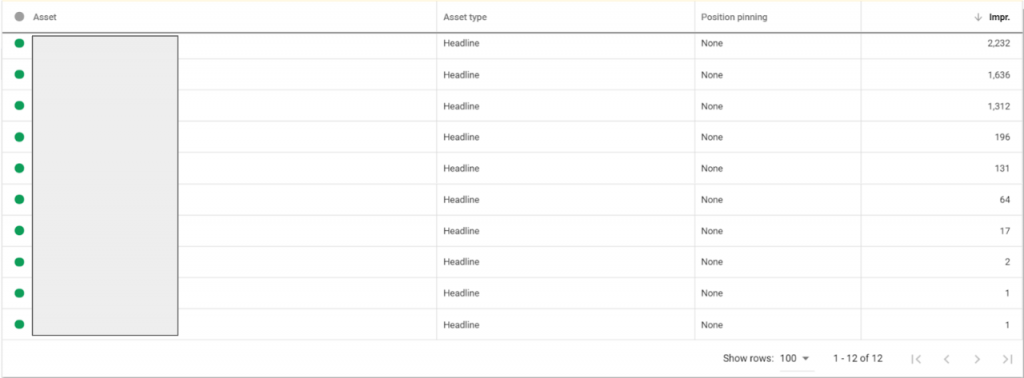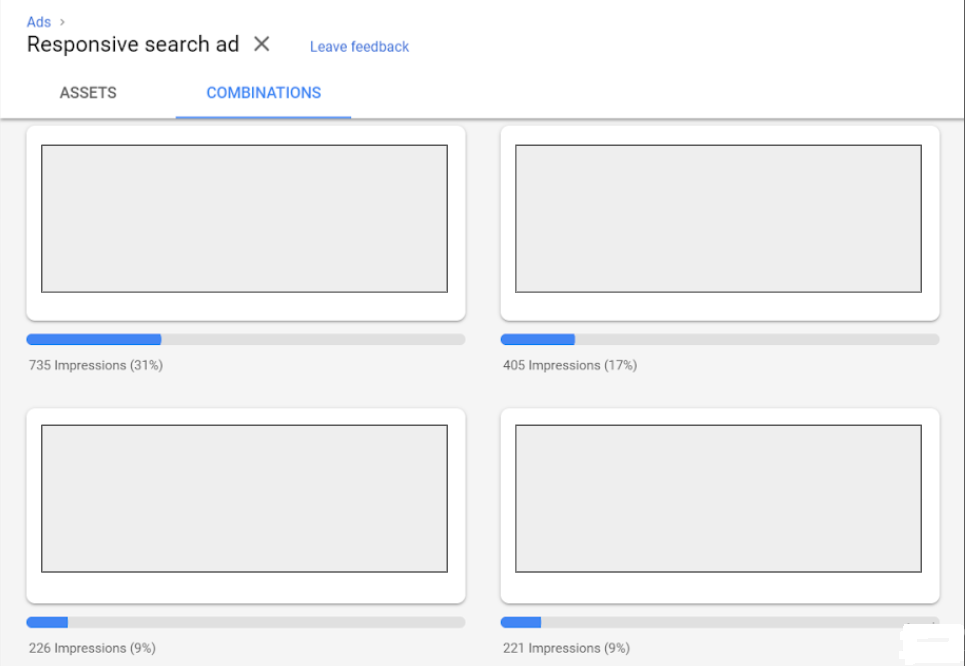What are Responsive Search Ads?
This is an ad format where you enter a bunch of different headlines and descriptions, and then the Google Ads System will test all the possible combinations of the headlines plus descriptions in order to (supposedly) find the best performing ads. Supposedly, that’s how it’s supposed to work. But in practice, it does not work that way at all.
Let’s take a look at these actual results from a responsive search ad.

So you can see there were ten different headlines being used here. The headline with the most impressions has over 2,000, and then two of the headlines have between 1,000 and 2,000 impressions, and then the rest of these headlines…not so much. You can see a few of them only have 1 or 2 impressions.
Let’s look at the description lines:

Here you can see that 2 of the descriptions are getting almost all of the impressions, and the other two are hardly getting any. One of them only got 4 impressions. So with 10 headlines and 4 description lines, that’s 40 different possible variations. Well, within Google ads, you can also look and see what the actual combinations were that Google put together for you, and you can see the individual data for the individual ad.
Now when you’re looking at these combinations, you can’t look at the all-time data. You can only look at about 90 days at a time. That’s why you’re seeing a lot fewer impressions here than with the previous image. But this is from the same ad.

You can see the top ad combination (this is just one of the headlines plus one of the description lines) has gotten 31% of the impressions. And if you total all 4 of the top ads that are showing, it’s over 60% of the impressions, going to just 4 ads out of the possible 40. And if we scroll down further, we could see that there were actually only 36 combinations used at all. Some of these only got 1 impression. So Google isn’t actually testing all of these combinations at all. They’re just picking a couple of ads that seem to work okay and they’re just running with it. They’re putting all of the impressions towards just a couple of the ads.
Now, these would all be fine if the results were actually better than regular text ads (like if Google somehow knew which headlines and descriptions were going to perform best, and that’s why they were only showing a few of them). But that is not the case! In every instance I’ve seen, responsive search ads are performing worse than regular text ads. At best, they’re performing about the same as regular text ads. I’ve never seen them perform better.
Google has amazing artificial intelligence. Their automated bidding is getting better and better. The system knows way more about people than we ever possibly could just by targeting the keywords they’re searching for. But when it comes to ads, when it comes to the written word, Google’s automation is not up to par with humans. That goes for automated Ad rotation, auto-apply ad suggestions, automated extensions, and responsive search ads.
Bottom line:
Responsive search ads do not work as well as writing your own complete ads, and then split testing those ads a couple at a time to keep improving your results…that’s what works.
If you want to discover more about what works with Google ads, check out my Advanced Google Ads training. This training isn’t about what used to work or what Google hopes will work. This is about what’s working now! This is about what’s working today! And it’s constantly being updated so you can always stay ahead of the crowd.
Click here for more information: https://secure.adleg.com/advanced-google-ads
